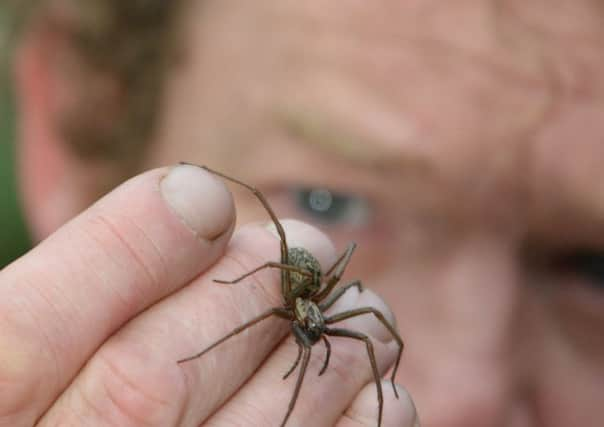Giant spiders set to invade homes this winter


The mild months have allowed the creepy critters to grow abnormally large and flourish by gorging on the plentiful supply of bugs.
Warm weather means more food, while windows being left open means they can easily crawl into homes.
Advertisement
Hide AdAdvertisement
Hide AdAnd with temperatures set to fall, experts have warned that more house spiders will soon be heading indoors to keep warm and look for a mate.
But while giant spiders crawling through homes might alarm residents, experts insist there is nothing to fear.
Kevin Thom, who runs therapy sessions for arachnophobes at Edinburgh Butterfly & Insect World, expects spiders to be more noticeable, but said many beliefs about the creatures were simply myths.
He said spiders in the UK rarely bite and are generally harmless – adding that their lack of vision means they won’t even know they have human company.
Mr Thom, who treats more women than men, said: “There has been a mild winter and a bit more beasties around, and I would be surprised if there was a shortage of spiders this year.”
His approach includes encouraging people to gently poke a house spider, building up to holding a tarantula in the palm of their hand.
In a bid to make the animals less threatening and “more mammalian”, Mr Thom refers to their legs as “paws” while “hairy” is substituted with “furry”.
He said: “I try to make them seem less alien and more familiar, bringing people’s fear down to a manageable level, and I can get people catching a house spider in three hours.
Advertisement
Hide AdAdvertisement
Hide Ad“Arachnophobia doesn’t discriminate. I have seen a hard-as-nails Royal Marine shudder at the thought of touching one.”
Mr Thom’s myth-busting theory works on the principle that the “more people know, the less they fear”.
He said spiders are unable to climb out of a bath or a cup because the surface is too slippery and won’t crawl into mouths while people are sleeping.
His methods helping arachnophobes become arachnophiles appear to work, as Becky Macandrew will testify.
The 28-year-old zoologist was once terrified even by pictures of the creatures – but she now works as head of spiders at Lasswade-based Butterfly & Insect World, and keeps pet tarantulas at home.
Ms Macandrew said: “I wouldn’t be able to do this job if it wasn’t for his help. It has been life-changing.
“Before I couldn’t have a shower if there was a spider in the bath or go to sleep if there was one in my bedroom. Now I love looking at them, and handle tarantulas every day.”
Mr Thom, who has been looking under logs ever since he was able to move them, has observed an increase in numbers and a change in species across the board, including types of spiders he has never seen before.
Advertisement
Hide AdAdvertisement
Hide AdBut at this time of year, homeowners are more likely to encounter the lovelorn – and almost totally blind – male house spider.
Ms Macandrew said: “They are just blind wee boys on a testosterone-fuelled mission.
“But the female’s mood can change very quickly, and she will often eat an amorous male because a snack gives her eggs the best start possible.”